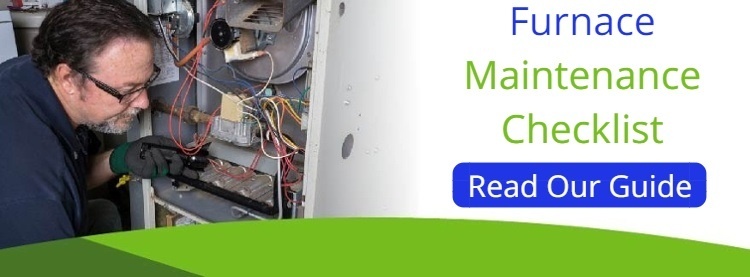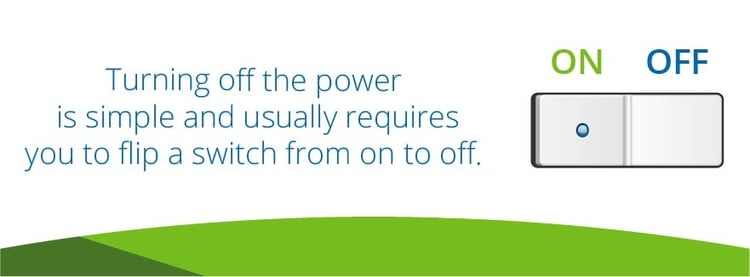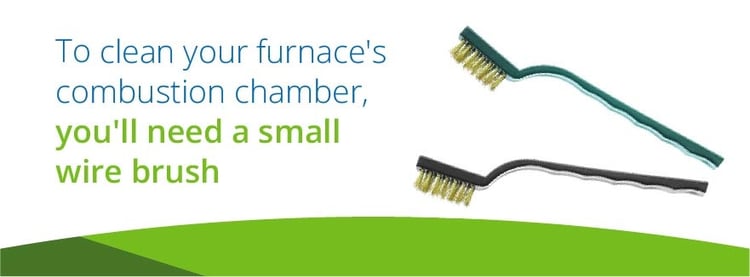
Are you ready for autumn? Although you've already packed up your summer clothes and set up your fall decorations, there's still much to do to prepare for the colder temperatures that accompany the season. Even though cold temperatures are right around the corner, many homeowners ignore fall furnace maintenance. In fact, fall furnace maintenance is exceedingly important, because no homeowner wants to be without heat on a chilly autumn night.
7 Step Oil Furnace Maintenance Checklist
- Turn Off Your Furnace
- Remove Carbon Soot and Other Debris
- Evaluate the Flue Pipe
- Replace Oil Filter
- Change Air Filter
- Adjust the Burner and Test Its Efficiency
- Clean Floor Vents
Fall furnace maintenance may seem like a costly endeavor at first, at least until you consider the numbers behind it. The average costs of a furnace repair range between $162 to $265, which likely means you won't have to worry about breaking your budget to fix or upgrade your furnace.

There are many benefits of fall furnace maintenance, including:
- Guarantee of Proper Furnace Airflow – A furnace tune-up ensures you can enjoy proper airflow throughout your home. Without proper airflow, your furnace could face added strain, resulting in increased repair costs down the line.
- Improved Safety – Make sure your furnace is working correctly without exception. With fall furnace maintenance, your furnace is more likely to remain safe and functional in frigid temperatures.
- Increased Energy Efficiency – An inefficient furnace may force you to pay higher-than-expected heating bills in fall and winter, but you improve your furnace's efficiency instantly with a furnace tune-up.
- Reduced Repair Costs – A furnace problem that goes unaddressed may wind up costing hundreds or thousands of dollars. If you devote a few minutes to maintain your furnace now, you could lower your furnace repair costs or eliminate some of the expenses altogether.
- Ensured Compliance With Manufacturer's Warranty – The manufacturer's warranty on your furnace may become void if you fail to perform regular furnace maintenance.
It doesn’t require a furnace expert to complete comprehensive furnace maintenance. A furnace maintenance checklist will help you take the guesswork out of furnace repairs. Here's our seven-step oil furnace maintenance and oil burner service checklist to ensure you can complete extensive furnace repairs with ease.
Step One: Turn Off Your Furnace

You'll first need to turn off your furnace before you embark on fall furnace maintenance. Fortunately, doing so is simple and usually requires you to flip a switch from on to off. It is crucial to switch off the furnace's electrical power and fuel supply prior to fall furnace maintenance, so you can protect yourself and your home while you perform any furnace maintenance.
Typically, a furnace's electrical power switch is located near the burner itself or at the top of your cellar stairs. It usually features a bright red power switch plate as well, making it easy to find. To turn off the furnace's fuel supply, you can use the fuel shutoff valve located near the oil tank or on the furnace's incoming gas pipe. This valve is clearly marked and simple to operate.
Step Two: Remove Carbon Soot and Other Debris From the Furnace's Combustion Chamber
Remove debris from your furnace's combustion chamber – you'll be glad you did! It may take some time to eliminate carbon soot, carbon dioxide, water vapor and other debris from this area, but you could reap the benefits of your cleaning efforts for an extended period of time.
The combustion chamber plays a key role in your furnace's day-to-day performance. A metal box surrounds the furnace's gas burners, and the burners’ flames heat it. Ultimately, the combustion chamber opens from the top to ensure hot gases from the burning process are vented to the exterior properly via a metal flue pipe. Meanwhile, the combustion chamber's walls keep these gases from entering your home.
Cleaning your furnace's combustion chamber prevents the build-up of debris on the chamber's walls that otherwise could result in corrosion. If you dedicate the necessary time and resources to clean the combustion chamber periodically, you may be able to minimize this risk.

To clean your furnace's combustion chamber, you'll need a small wire brush. This simple tool empowers you to remove loose material from the chamber's wall. Also, you may want to use an industrial shop vacuum for in-depth maintenance.
Don't forget to check the combustion chamber for cracks or holes, too. A single crack or hole may require you to replace your combustion chamber to ensure optimal furnace performance.
Step Three: Evaluate the Flue Pipe
Your furnace's flue system serves an important purpose: to ensure your furnace’s combustion products exit your home properly. Pay special attention to the flue pipe, so you can identify any cracks, holes or leaks immediately.
Conduct an extensive assessment of the flue pipe, particularly where the pipe meets the furnace. If you notice minor holes, you may be able to patch them with foil tape for a short-term fix. Large holes may require you to replace the flue pipe or furnace.
Keep a close eye on the flue pipe's barometric damper, a piece used to control the draft inside the furnace. The barometric damper is available on a furnace that features a Category I vent, which is part of a furnace that has an annual fuel utilization efficiency below 83%, and regulates the furnace's draft. In most cases, the barometric damper functions as a round tee that is inserted in the flue vent connector between the furnace and chimney. It features a round door with an adjustable weight, so you can adjust the barometric damper to guarantee your furnace runs efficiently.
To adjust the barometric damper, locate the weights and scale on the device. Then, follow the furnace manufacturer's instructions. The manufacturer will provide a standard number you can use as a guideline to guarantee the furnace is running at a normal temperature consistently.
Modifying the barometric damper enables you to conserve energy and fuel, as well as minimize lost heat from the furnace. If you're uncertain about how to adjust the barometric damper's weights and scale, contact the furnace manufacturer for additional guidance.
Step Four: Replace the Oil Filter
When was the last time you replaced your furnace's oil filter? If you're not sure, replace it now to ensure your furnace can remain operational in cold temperatures. The oil filter stops small impurities from clogging the oil-burner nozzle — something that might cause your furnace to misfire and shut down. It should be replaced at least twice per heating season, and the replacement process can be completed in only minutes.
Usually, the oil filter is located close to the furnace because it purifies oil before the fuel enters the furnace. To change the oil filter, close the oil valve and remove the old filter. Install the new oil filter and dispose of the old one properly according to local hazardous waste regulations — it's that simple!
Step Five: Change the Air Filter
After you've replaced the oil filter, address the air filter. Replacing it can be a fast, simple process as well. Before you begin, be sure to purchase the correct air filter for your furnace. Remember, not all air filters are identical, so you should find the right one that fits your furnace perfectly.
Remove the air filter, which is located inside the furnace or inside the furnace's return air vent. You'll also want to look for an arrow that indicates the airflow direction. Knowing the airflow direction ensures you'll know which way to install your new air filter. For many people, it often helps to use a permanent marker to draw an arrow on the outside of the furnace that shows the device's airflow direction.
Slide the new air filter into place and record the date of your air filter replacement. Ideally, you should try to replace the air filter every one to three months, depending on the size of your home, whether there are pets or smokers in your house and your furnace model.
Step Six: Adjust the Burner and Test Its Efficiency
Ready to test your burner's efficiency? To do so, you'll need to complete a combustion analysis to measure gases in a furnace's exhaust flue and calculate its efficiency.
Combustion analysis serves two purposes: to help you bolster your furnace's efficiency and ensure your furnace can perform safely. This analysis requires you to measure the flue gas concentrations and gas temperature, along with the furnace's draft pressure and soot level.
To calculate your furnace's gas concentration, insert a probe into the exhaust flue to extract a gas sample. The exhaust gas temperature can then be measured with a thermocouple, which will determine the highest exhaust gas temperature. Meanwhile, you'll also be able to measure the draft, the differential pressure between the inside and outside of your furnace's exhaust flue, and calculate the soot based on a gas sample from the exhaust flue.
After you perform a combustion analysis, you'll have a vast assortment of data to help you examine the efficiency and safety of your furnace. This data can also be used to evaluate combustion parameters such as excess air and combustion efficiency.
During a combustion analysis, you can utilize a combustion analyzer to collect measurements. This analyzer serves as a portable electronic instrument that allows you to extract a sample from a flue with a vacuum pump and evaluate the sample via electrochemical gas sensors. A thermocouple is commonly used for stack and combustion air temperature measurements.
Step Seven: Clean the Floor Vents
Cleaning the floor vents represents the final step of the furnace maintenance process. Though this task might seem tedious, it is important to ensure your floor vents remain free of dirt, dust, pet hair and other debris for consistent furnace performance.
Taking a few minutes to vacuum the floor vents and remove any debris can make a world of difference relative to your furnace's overall performance. In addition, clean floor vents will ensure you can maximize the efficiency of your furnace and prevent vent debris from impacting the air quality throughout your home.
Key Considerations for Fall Furnace Maintenance
Fall furnace maintenance can deliver long-lasting results. As such, understanding the steps to perform proper furnace maintenance is essential. Before you embark on furnace maintenance, there are several key considerations to remember:
- Maintain Safe Working Conditions. If you're working with a gas furnace, you'll want to do everything you can to guarantee you're working in safe conditions. In addition to turning off your gas system, make sure that the entire power system and any circuits connected to the furnace are inactive. If you discover a gas leak, contact a furnace professional for immediate assistance.
- Check Your Thermostat. Fall furnace maintenance is ideal because it will allow you to address potential issues with your furnace's efficiency. If you feel uncomfortable with a room's temperature after you've performed extensive furnace maintenance, there may be a problem with your home's thermostat. If you turn up the temperature on your thermostat but still notice your home is too cold, the problem may stretch beyond your furnace.
- Inspect the Fan. Are your furnace's fan components working correctly? Debris may affect a fan's performance, so you'll want to inspect your furnace's fan and clean it as needed.
- Be Cautious. When it comes to your furnace, don’t leave anything to chance. Consult with a professional if you are unsure about how to perform effective furnace maintenance. This will ensure any repairs are completed safely and efficiently.
- Know Your Furnace. Your furnace may have served you well for nearly two decades, but despite your best maintenance efforts, it might struggle to perform this fall. Prepare for the possibility that you may need to replace your furnace. Most homeowners spend between $2,298 and $5,550 for a new furnace installation. If your furnace is getting older, it may be a good time to start saving for a potential replacement.

Fall furnace maintenance is not foolproof, and problems still might arise with your furnace even if you properly maintain it. When you’re dealing with a furnace issue, work with trusted and experienced energy professionals who will keep your home at a comfortable temperature year-round.
Need a professional? We offer a variety of home energy services to ensure you can heat your home effectively. As part of your maintenance this year, consider Smart Touch Energy’s burner service, repair and cleaning options to prepare for the winter months ahead. Make sure to also check out our heating oil prices & deliver options and top off your tank today!



